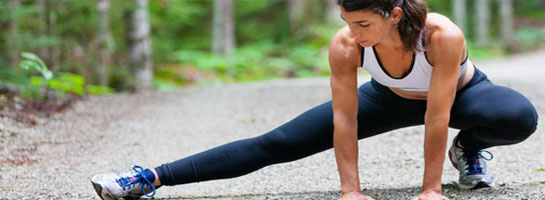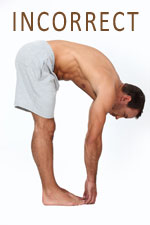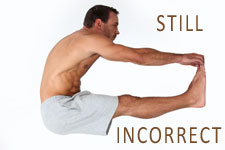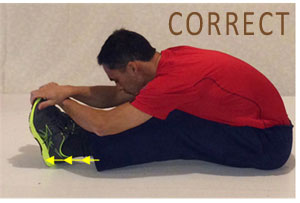How To Stretch Your Hamstrings Safely To Prevent Back Problems
Sherwin Nicholson | Updated May 6, 2020

The Pelvic Dilemma
Poor Hamstrings = Poor Back
If you are among the majority of people who are experiencing pain, you most likely also have tight or shortened hamstrings. And they can become one of your worst enemies.
When these muscles aren’t long and flexible enough, you can’t perform everyday tasks properly. Your upper body ends up doing most of the hard work and that’s real bad for your discs.
Remember, the more active your legs remain, the less your upper body will strain.
But what do they have to do with the back?
Your hamstrings attach from your femur to your pelvis. So anything that affects their movement affect the pelvis and then causes your spine to bend more.
Any reduced length restricts the pelvis from moving together with the back as the upper body moves.
You’ve got to keep your pelvis moving and tilting while you bend! This is to keep your spine from bending only.
It is important that the pelvis tilts independently of the legs and with the spine and you lean forward. Tilting allows the spine to maintain its natural and safer lumbar curve. This curve is what is needed to prevent disc injury.
If your pelvis becomes less mobile, you can develop a hyper-mobile lower back. When it becomes too mobile, there will be too much stress on your discs.
Overuse of the smaller lower muscles causes fatigue and possible spasm. Spasms trigger as a result of the muscle to prevent the joint from being at risk of a possibility of increased injury.
You can injure yourself more than you realize
If you don’t take steps to correct this problem, disc pressure can become unbalanced leading to significant muscle strain, excessive disc bulge, herniation, rupture, and pain will eventually follow.
Tightening, therefore, restricts the pelvis which then affects the lower back. It would then seem important that to improve pelvic mobility, the hamstrings and also the quadriceps should be conditioned to allow the pelvis to move more dynamically with the spine.
Avoid Dangerous Stretches
Have you ever been taught that you should bend over while standing or lean forward while sitting to reach your toes to stretch? This is very bad for you and does nothing to lengthen your hamstrings!
This technique should be avoided at all costs

Many fitness instructors, doctors, coaches and various other sources advise of this technique but don’t realize that there is a much safer option available.
These type of movements are meant to recondition the muscle but don’t address joint issues. As all skeletal muscles cross a joint, stretching (to most degrees) will have a direct impact on them. Although the hamstring muscles do not cross the lumbar joints, the action of lengthening them affects them directly as they are used as a lever to facilitate the movement.
Because the lumbar discs are at the center (axis) of this lever, they are the most vulnerable especially the L5-S1 disc. The amount of pressure (unbalanced of course) placed on this disc while trying to move very resistant, tight hip and hamstring muscles, are extremely high.  This disc is usually the first disc to wear from abuse, herniate and degenerate. When this disc has become less supportive, the L4-L5 is the next disc to be affected negatively.
This disc is usually the first disc to wear from abuse, herniate and degenerate. When this disc has become less supportive, the L4-L5 is the next disc to be affected negatively.
When you don’t have disc or vertebral issues, you can certainly use a more aggressive method to lengthen your hamstrings. To be on the safe side, make sure that your back does not move and that only your hip and knee joint does.
Safer Hamstring Stretches
An important and much safer way to perform it, is the SAFER, SEATED HAM STRETCH. This technique prevents any injury to the lumbar spine as only the hamstrings move during this exercise.
This exercise isolates the groups while protecting the lumbar spine from an injury that would otherwise occur in more common and less safe methods.
Another benefit is that it encourages the pelvis to remain aligned and in support of the spine before you begin. Keeping your pelvis steady is opposite to the standard stretches where your pelvic tilt is not stable.
For fully detailed information and instructions on HOW to do it:
Read the SEATED HAMSTRING STRETCH page.

This is the end movement. How to get there is what really matters.
Are you looking for the right guide to recondition your hams and relieve the pain? Get the guide and begin today!
Do you need more help with your hams?
Learn the better stretch for your legs
Follow this one simple rule and save your back!
A Safe Downloadable Guide to Protect You
References:
- Management of chronic lbp.Bogduk N1.-http://www.ncbi.nlm.nih.gov/pubmedhealth/PMH0004665/
- Does exercise increase or decrease pain? Central mechanisms underlying these two phenomena. – Lima LV1, Abner TS1, Sluka KA1. J Physiol. 2017 Mar 29. doi: 10.1113/JP273355.
- Predictors of response to exercise therapy for chronic lbp: result of a prospective study with one year follow-up. – Cecchi F(1), Pasquini G, Paperini A, Boni R, Castagnoli C, Pistritto S, Macchi C. 1. Eur J Phys Rehabil Med. 2014 Jan 16. [Epub ahead of print] PMID: 24429917 [PubMed – as supplied by publisher]
- www.mayoclinic.com
